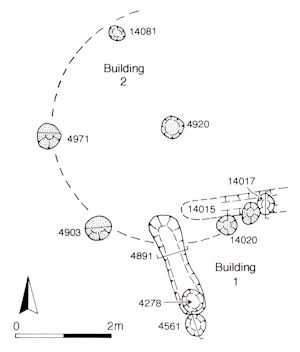
Although no great span of time or startling change is represented, at least two sub-phases of activity can be discerned from the inter-cut complexity of Period 2B features within OA28 (Figure 38). The later activity is distinguished by post-dating a dump episode, which seals the earlier features as previously described in Southern zone, Open Area 28.
A patchy dumping sequence overlies Building 2 (4848, 4918, 4937, 4938 Group 271). This soil is presumably a remnant of a more extensive deposit. Layer 4937 includes metalworking debris, though this may derive from the underlying pits.

The dump deposits are cut by two slots (Figure 39), set at an approximate right angle to each other (Group 272). Slot 4891 is 2.2m long, 0.5m wide and 0.4m deep. Slot 14015 is probably a similarly proportioned feature, though neither end was determined. Each slot contains an apparently integral post-hole, 4278 and 14017 respectively, set into its base (Group 273). It is likely that further structural components of this building lie unexcavated to the south and east. The grog-tempered pottery from the fills of the Building 1 structural features provides a Late Iron Age date. Burnt daub fragments occur in the fills and may derive from the fabric of the building.
Tangible activity in OA28 is dominated by pitting. Some of these pits have already been described as possibly contemporary with Period 2A activity (Group 62), but this distinction is not clear cut and the OA28 pit sequence may more realistically represent a continuous process throughout Period 2 - particularly if the groundworks of the settlement remodelling do not extend this far south.
A number of these pits (4193, 4258, 4291, 4327, 4331, 4463, 4469, 4655, 4786, 4998, 14064, 14074, 14077 Group 276) are filled during the first half of the 1st century AD and at least two (4193, 4496) receive material mainly during the mid-1st century AD. These latest Period 2B pits fall squarely within the LIA/early Roman transition period. Though variable in size, they are on average larger than preceding examples. Relatively few are inter-cut. Pits 4655 and 4658 seem to be later additions to the large inter-cutting Period 2A complex (Group 62) and may indicate that such concentrations of pitting developed over prolonged periods of time. Other pits, with less datable assemblages (4157, 4240, 4275, 4372, 4374, 4482, 4504, 4509, 14047 Group 278), can only be broadly dated to the Late Iron Age, though a constituent pit post-dates hearth 14104 (Group 274).
The pottery assemblages of the latest of the pits include an element of Romanising pottery, often together with a few fragments of tile. Typically the overall assemblages are more varied than from earlier pits: pits 4258 and 4463 contain notable quantities of metal objects and waste, while 4786 also features metalworking debris, including mould fragments.
Late Iron Age pit 4984 (Group 277) post-dates Building 1.
Internet Archaeology is an open access journal based in the Department of Archaeology, University of York. Except where otherwise noted, content from this work may be used under the terms of the Creative Commons Attribution 3.0 (CC BY) Unported licence, which permits unrestricted use, distribution, and reproduction in any medium, provided that attribution to the author(s), the title of the work, the Internet Archaeology journal and the relevant URL/DOI are given.
Terms and Conditions | Legal Statements | Privacy Policy | Cookies Policy | Citing Internet Archaeology
Internet Archaeology content is preserved for the long term with the Archaeology Data Service. Help sustain and support open access publication by donating to our Open Access Archaeology Fund.